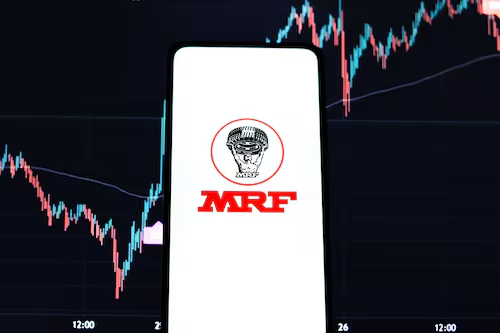On June 13, 2023, MRF (Madras Rubber Factory) made history as India’s first stock to hit a share price of Rs1 lakh, sparking debates on Dalal Street about its affordability and investment potential. Let’s unpack this milestone and assess whether MRF is a stock worth considering for your portfolio.
MRF’s Milestone in Context
MRF’s Rs1 lakh price tag is a psychological barrier, but is it truly expensive? Compare it to Berkshire Hathaway, where Class A shares trade at over $500,000 (roughly Rs4 crore). In this light, MRF’s price seems less daunting. However, price alone doesn’t determine value—let’s dig into why MRF’s stock commands such a premium and whether it’s justified.
Why Is MRF’s Stock Price So High?
Unlike many companies that split stocks to make shares more affordable, MRF has never split its shares. It issued bonus shares in 1970 (1:2) and 1975 (3:10), but none since. With a fixed number of outstanding shares, MRF’s growth over decades—fueled by its dominance in India’s tyre industry—has driven its market value and share price upward. As of July 2025, MRF’s market capitalization stands at approximately Rs61,462 crore, reflecting its scale but not placing it among India’s top 100 listed firms.
Price vs. Value: Debunking the Myth
A high share price doesn’t equate to a high-quality stock. Valuation metrics like price-to-earnings (P/E) and price-to-book (P/B) ratios offer a clearer picture. MRF’s P/E ratio, as of July 2025, is around 32.90, significantly higher than peers like Apollo Tyres (20.3), Ceat (17.9), JK Tyre (14.2), and Balkrishna Industries (28.7). Its P/B ratio is 3.32, also above the industry median of 3.08. These figures suggest MRF is pricier than competitors, but a high P/E can reflect strong growth expectations—or overvaluation.
MRF’s performance lags behind its peers. Over the past three years, MRF delivered a 100.64% return, impressive but dwarfed by Apollo Tyres (284.4%), Ceat (122.3%), and JK Tyre (219.68%). Over five years, MRF’s 113.9% return trails the Sensex’s 77%. This underperformance raises questions about whether its premium valuation is warranted.
MRF’s Financial Snapshot
For the fiscal year ending March 2025, MRF reported revenue of Rs28,153 crore (up 12% year-on-year) and a net profit of Rs1,869 crore (down 10% from Rs2,081 crore in FY24). Its return on equity (ROE) was 10.11%, lower than its five-year average of 13.25%. Despite solid revenue growth, profit margins have faced pressure from rising commodity prices, particularly natural rubber, and competitive dynamics. MRF’s operating margin in Q3 FY25 contracted to 6% from 11.27% a year earlier, reflecting cost challenges.
Peer Comparison: Is MRF Overpriced?
MRF’s P/E ratio of 32.90 is notably higher than its peers, indicating investors are paying a premium for each rupee of earnings. Here’s a quick comparison as of July 2025:
- Apollo Tyres: P/E 20.3, 3-year return 284.4%
- Ceat: P/E 17.9, 3-year return 122.3%
- JK Tyre: P/E 14.2, 3-year return 219.68%
- Balkrishna Industries: P/E 28.7, 3-year return 49.2%
MRF’s dividend yield of 0.14% is also lower than peers like Apollo Tyres (1.12%) and Ceat (0.82%), making it less attractive for income-focused investors. Analyst consensus leans cautious, with a median target price of Rs1,33,654, suggesting potential downside from the current price of Rs1,43,965.
MRF’s Unique Strengths
MRF remains India’s largest tyre manufacturer, with a strong presence in passenger cars, two-wheelers, trucks, and even fighter aircraft tyres. Its brand equity, innovation, and leadership in the OEM market bolster its appeal. The company’s expansion into electric vehicle tyres and a robust export outlook add growth potential. Additionally, MRF’s high share price may deter speculative trading, reducing volatility compared to lower-priced stocks.
Should You Invest?
MRF’s Rs1 lakh price tag is a function of its no-split policy and steady growth, not necessarily overvaluation. However, its high P/E ratio and weaker performance compared to peers suggest caution. Ask yourself:
- What’s your investment horizon? MRF’s long-term CAGR of 24.98% (2002-2025) highlights its wealth-creation potential, but short-term gains may be limited.
- Are you comfortable with its valuation? At 32.9x earnings, MRF is pricier than competitors, with analysts suggesting a potential 31% downside.
- What’s your goal? If seeking growth, peers like Apollo or JK Tyre may offer better returns. If stability and brand strength matter, MRF’s market leadership is a plus.
The stock market rewards forward-looking decisions. MRF’s fundamentals are solid, but its high valuation and competitive pressures warrant careful evaluation. Consider waiting for a price correction or clearer signs of margin recovery before investing. For now, MRF’s Rs1 lakh tag is a headline, not a guarantee of value.

